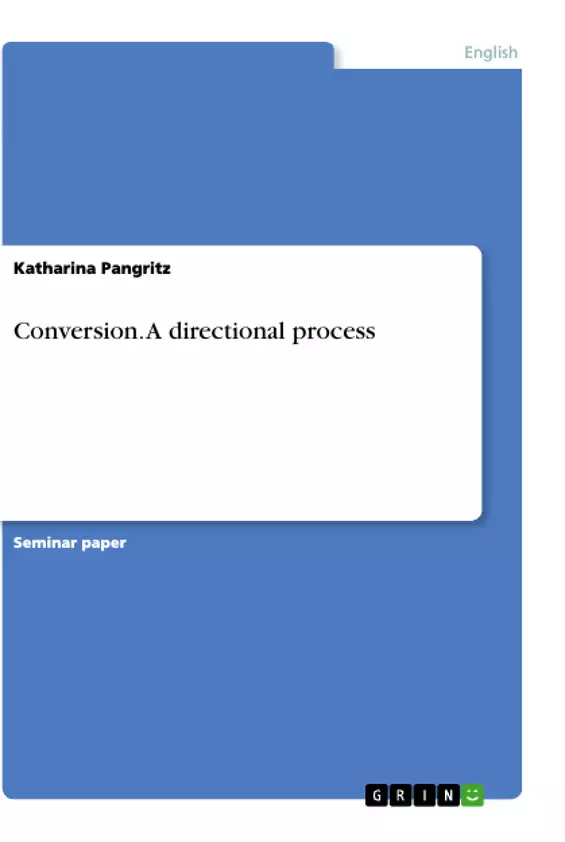In this work the author will give a short extract of important theories dedicated to the phenomenon of conversion. The author will present the theory of Marchand, who believes in conversion as a process of zero-derivation. In addition to that the theory of metonymical extension by Rene Dirven will be introduced. As a contrast the theories of linguists such as Hockett and Koziol will be analysed, which see conversion as a state and not as a process. They apply to conversion as multifunctionality. The author will emphasize conversion as a process and consequently will illustrate a directionality of conversion. On the basis of the words "mountain" and "saw" of the OED the source word and target word will be detected. In order to prove the directionality of conversion their individual semantics by the semantic criteria of Marchand will be analysed.
At first sight conversion as a linguistic subject seems to be unproblematic and simple. On the surface it can be defined as a phenomenon of linguistics in which certain words are created by changing the lexical category of another word with no obvious change of its external form. In this way conversion creates verbs from nouns, nouns from verbs, and even verbs from adjectives.
However, conversion is not as simple as it seems. It is a linguistic phenomenon, which occurs above all in the English Language. There is a high extent of words in English texts, which belong to several word classes. Even though the phenomenon of conversion has such a high presence within the English language, linguists worldwide have not yet found an agreement about its definition. Several different and contradictory definitions exist within the literature of linguistics. There are various opinions of linguists, in which field Conversion should be included.
Inhaltsverzeichnis (Table of Contents)
- 1 Introduction
- 2 Theories of conversion
- 2.1 Marchand: Zero derivation
- 2.2 Dirven: Metonymical extension
- 2.3 Multifunctionality
- 3 The directionality of conversion
- 4 Analysis of Words of the OED
- 4.1 'mountain'
- 4.2 'saw'
- 5 Conclusion
- 6 References
Zielsetzung und Themenschwerpunkte (Objectives and Key Themes)
This term paper explores the phenomenon of conversion in linguistics, focusing on its directionality as a process. The study examines various theories of conversion, particularly the theories of Marchand and Dirven, and analyzes the semantic changes involved in converting nouns and verbs.
- Theories of Conversion: Zero derivation, metonymical extension, and multifunctionality.
- The Directionality of Conversion: Analyzing the process of converting nouns to verbs and verbs to nouns.
- Semantic Analysis: Applying semantic criteria to understand the changes in meaning during conversion.
- Case Studies: Examining the conversion of the words "mountain" and "saw" from the Oxford English Dictionary (OED).
- Critical Evaluation: Discussing the strengths and weaknesses of various theories and approaches to conversion.
Zusammenfassung der Kapitel (Chapter Summaries)
- Introduction: The chapter introduces the concept of conversion as a linguistic phenomenon, highlighting its complexity and the ongoing debate among linguists regarding its definition and categorization. It emphasizes the prevalence of conversion in the English language and the challenges of establishing a unified definition.
- Theories of conversion: This chapter delves into prominent theories surrounding conversion. It explores the theory of zero-derivation proposed by Marchand, where a word retains its original category while simultaneously belonging to another. It then contrasts this with Dirven's theory of metonymical extension, which sees conversion as an expansion of meaning within a specific event context.
- The directionality of conversion: This chapter focuses on the directional nature of conversion, analyzing the process of converting nouns into verbs and vice versa. It examines how the original meaning of a word evolves and shifts during the conversion process.
- Analysis of Words of the OED: This chapter presents a detailed analysis of the words "mountain" and "saw" from the Oxford English Dictionary (OED). It explores their semantic evolution, identifying the source word and target word in their conversion, and applying semantic criteria to understand the directionality of the process.
Schlüsselwörter (Keywords)
The key topics and concepts explored in this work include conversion, zero-derivation, metonymical extension, multifunctionality, directionality of conversion, semantic analysis, source word, target word, Oxford English Dictionary (OED), and linguistic theory.
- Quote paper
- Katharina Pangritz (Author), 2012, Conversion. A directional process, Munich, GRIN Verlag, https://www.grin.com/document/511786




